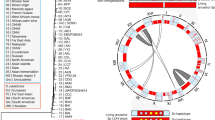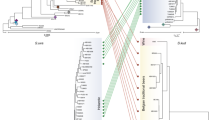Abstract
Hybridization is recognized as a powerful mechanism of speciation and a driving force in generating biodiversity. However, only few multicellular species, limited to a handful of plants and animals, have been shown to fulfil all the criteria of homoploid hybrid speciation. This lack of evidence could lead to the interpretation that speciation by hybridization has a limited role in eukaryotes, particularly in single-celled organisms. Laboratory experiments have revealed that fungi such as budding yeasts can rapidly develop reproductive isolation and novel phenotypes through hybridization, showing that in principle homoploid speciation could occur in nature. Here, we report a case of homoploid hybrid speciation in natural populations of the budding yeast Saccharomyces paradoxus inhabiting the North American forests. We show that the rapid evolution of chromosome architecture and an ecological context that led to secondary contact between nascent species drove the formation of an incipient hybrid species with a potentially unique ecological niche.
This is a preview of subscription content, access via your institution
Access options
Subscribe to this journal
Receive 12 digital issues and online access to articles
$119.00 per year
only $9.92 per issue
Buy this article
- Purchase on Springer Link
- Instant access to full article PDF
Prices may be subject to local taxes which are calculated during checkout






Similar content being viewed by others
References
Barton, N. H. & Hewitt, G. Analysis of hybrid zones. Annu. Rev. Ecol. Syst. 16, 113–148 (1985).
Rieseberg, L. H., Van Fossen, C. & Desrochers, A. M. Hybrid speciation accompanied by genomic reorganization in wild sunflowers. Nature 375, 313–316 (1995).
The Heliconius Genome Consortium. Butterfly genome reveals promiscuous exchange of mimicry adaptations among species. Nature 487, 94–98 (2012).
Lukhtanov, V. A., Shapoval, N. A., Anokhin, B. A., Saifitdinova, A. F. & Kuznetsova, V. G. Homoploid hybrid speciation and genome evolution via chromosome sorting. Proc. R. Soc. Lond. B 282, 20150157 (2015).
Schumer, M., Rosenthal, G. G. & Andolfatto, P. How common is homoploid hybrid speciation? Evolution 68, 1553–1560 (2014).
Greig, D., Louis, E. J., Borts, R. H. & Travisano, M. Hybrid speciation in experimental populations of yeast. Science 298, 1773–1775 (2002).
Charron, G., Leducq, J. B., Bertin, C., Dube, A. K. & Landry, C. R. Exploring the northern limit of the distribution of Saccharomyces cerevisiae and Saccharomyces paradoxus in North America. FEMS Yeast Res. 14, 281–288 (2014).
Hyma, K. E. & Fay, J. C. Mixing of vineyard and oak-tree ecotypes of Saccharomyces cerevisiae in North American vineyards. Mol. Ecol. 22, 2917–2930 (2013).
Maganti, H., Bartfai, D. & Xu, J. Ecological structuring of yeasts associated with trees around Hamilton, Ontario, Canada. FEMS Yeast Res. 12, 9–19 (2012).
Sniegowski, P. D., Dombrowski, P. G. & Fingerman, E. Saccharomyces cerevisiae and Saccharomyces paradoxus coexist in a natural woodland site in North America and display different levels of reproductive isolation from European conspecifics. FEMS Yeast Res. 1, 299–306 (2002).
Boynton, P. J. & Greig, D. The ecology and evolution of non-domesticated Saccharomyces species. Yeast 31, 449–462 (2014).
Liti, G. et al. Population genomics of domestic and wild yeasts. Nature 458, 337–341 (2009).
Bergstrom, A. et al. A high-definition view of functional genetic variation from natural yeast genomes. Mol. Biol. Evol. 31, 872–888 (2014).
Koufopanou, V., Hughes, J., Bell, G. & Burt, A. The spatial scale of genetic differentiation in a model organism: the wild yeast Saccharomyces paradoxus. Phil. Trans. R. Soc. Lond. B 361, 1941–1946 (2006).
Kuehne, H. A., Murphy, H. A., Francis, C. A. & Sniegowski, P. D. Allopatric divergence, secondary contact, and genetic isolation in wild yeast populations. Curr. Biol. 17, 407–411 (2007).
Leducq, J. B. et al. Local climatic adaptation in a widespread microorganism. Proc. R. Soc. B. Biol. Sci. 281, 20132472 (2014).
Charron, G., Leducq, J. B. & Landry, C. R. Chromosomal variation segregates within incipient species and correlates with reproductive isolation. Mol. Ecol. 23, 4362–4372 (2014).
Ellison, C. E. et al. Population genomics and local adaptation in wild isolates of a model microbial eukaryote. Proc. Natl Acad. Sci. USA 108, 2831–2836 (2011).
Sylvester, K. et al. Temperature and host preferences drive the diversification of Saccharomyces and other yeasts: a survey and the discovery of eight new yeast species. FEMS Yeast Res. 15 (2015).
Samani, P. et al. Metabolic variation in natural populations of wild yeast. Ecol. Evol. 5, 722–732 (2015).
Filteau, M., Lagace, L., LaPointe, G. & Roy, D. Correlation of maple sap composition with bacterial and fungal communities determined by multiplex automated ribosomal intergenic spacer analysis (MARISA). Food Microbiol. 28, 980–989 (2011).
Karley, A., Douglas, A. & Parker, W. Amino acid composition and nutritional quality of potato leaf phloem sap for aphids. J. Exp. Biol. 205, 3009–3018 (2002).
Finlay, B. J. Global dispersal of free-living microbial eukaryote species. Science 296, 1061–1063 (2002).
Liti, G., Barton, D. B. & Louis, E. J. Sequence diversity, reproductive isolation and species concepts in Saccharomyces. Genetics 174, 839–850 (2006).
Neafsey, D. E. et al. Population genomic sequencing of Coccidioides fungi reveals recent hybridization and transposon control. Genome Res. 20, 938–946 (2010).
Walsh, J. B. Rate of accumulation of reproductive isolation by chromosome rearrangements. Am. Nat. 120, 510–532 (1982).
Loidl, J., Jin, Q.-W. & Jantsch, M. Meiotic pairing and segregation of translocation quadrivalents in yeast. Chromosoma 107, 247–254 (1998).
Zhang, H., Skelton, A., Gardner, R. C. & Goddard, M. R. Saccharomyces paradoxus and Saccharomyces cerevisiae reside on oak trees in New Zealand: evidence for migration from Europe and interspecies hybrids. FEMS Yeast Res. 10, 941–947 (2010).
Hewitt, G. M. Hybrid zones—natural laboratories for evolutionary studies. Trends Ecol. Evol. 3, 158–167 (1988).
Hou, J., Friedrich, A., Gounot, J. S. & Schacherer, J. Comprehensive survey of condition-specific reproductive isolation reveals genetic incompatibility in yeast. Nature Commun. 6, 7214 (2015).
Huerta-Sanchez, E. et al. Altitude adaptation in Tibetans caused by introgression of Denisovan-like DNA. Nature 512, 194–197 (2014).
Magwene, P. M. et al. Outcrossing, mitotic recombination, and life-history trade-offs shape genome evolution in Saccharomyces cerevisiae. Proc. Natl Acad. Sci. USA 108, 1987–1992 (2011).
Dunn, B. et al. Recurrent rearrangement during adaptive evolution in an interspecific yeast hybrid suggests a model for rapid introgression. PLoS Genet. 9, e1003366 (2013).
Libkind, D. et al. Microbe domestication and the identification of the wild genetic stock of lager-brewing yeast. Proc. Natl Acad. Sci. USA 108, 14539–14544 (2011).
Wang, Q. M., Liu, W. Q., Liti, G., Wang, S. A. & Bai, F. Y. Surprisingly diverged populations of Saccharomyces cerevisiae in natural environments remote from human activity. Mol. Ecol. 21, 5404–5417 (2012).
Keller, I. & Seehausen, O. Thermal adaptation and ecological speciation. Mol. Ecol. 21, 782–799 (2012).
Ordonez, A. & Williams, J. W. Climatic and biotic velocities for woody taxa distributions over the last 16 000 years in eastern North America. Ecol. Lett. 16, 773–781 (2013).
Scannell, D. R. et al. The awesome power of yeast evolutionary genetics: new genome sequences and strain resources for the Saccharomyces sensu stricto genus. Genes Genom. Genet. 1, 11–25 (2011).
Langmead, B. & Salzberg, S. L. Fast gapped-read alignment with Bowtie 2. Nature Methods 9, 357–359 (2012).
Li, H. et al. The sequence alignment/map format and SAMtools. Bioinformatics 25, 2078–2079 (2009).
Garrison, E. & Marth, G. Haplotype-based variant detection from short-read sequencing. Preprint at http://arXiv.org/abs/1207.3907 (2012).
Guindon, S. et al. New algorithms and methods to estimate maximum-likelihood phylogenies: assessing the performance of PhyML 3.0. Syst. Biol. 59, 307–321 (2010).
Falush, D., Stephens, M. & Pritchard, J. K. Inference of population structure using multilocus genotype data: linked loci and correlated allele frequencies. Genetics 164, 1567–1587 (2003).
Rochette, S. et al. Genome-wide protein–protein interaction screening by protein-fragment complementation assay (PCA) in living cells. J. Visual. Exp., e52255 (2015).
Diss, G., Dube, A. K., Boutin, J., Gagnon-Arsenault, I. & Landry, C. R. A systematic approach for the genetic dissection of protein complexes in living cells. Cell Rep. 3, 2155–2167 (2013).
Goudet, J. HIERFSTAT, a package for R to compute and test hierarchical F-statistics. Mol. Ecol. Notes 5, 184–186 (2005).
Simpson, J. T. et al. ABySS: a parallel assembler for short read sequence data. Genome Res. 19, 1117–1123 (2009).
Darling, A. C., Mau, B., Blattner, F. R. & Perna, N. T. Mauve: multiple alignment of conserved genomic sequence with rearrangements. Genome Res. 14, 1394–1403 (2004).
Drummond, A. J. & Rambaut, A. BEAST: Bayesian evolutionary analysis by sampling trees. BMC Evol. Biol. 7, 214 (2007).
Acknowledgements
The authors thank A. K. Dubé, K. Lambert, R. Nuwal, S. Haughian, A.-E. Chrétien, M. Caouette, I. Kukavica-Ibrulj, R. Levesque and the IBIS sequencing platform (B. Boyle) for technical help, P. Sniegowski, M.-A. Lachance and J. Anderson for providing strains, I. Levade and C. Lemieux for discussions and N. Aubin-Horth, A. Moses, L. Bernatchez, J. Shapiro, S. Pavey, F. Rousseau-Brochu, I. Gagnon-Arsenault, A.K. Dubé, A.-M. Dion-Côté, H. Vignaud and M. Nigg for comments on the manuscript. Funding support was provided by a NSERC Discovery Grant and an HFSP grant (RGY0073/2010) to C.R.L., FRQS fellowships to J.-B.L., NSERC USRA summer scholarships to L.N.T., FRQNT and NSERC PhD fellowships to G.C. Some of this material (yeast collection) is based on work supported by the National Science Foundation under grant no. DEB-1253634 (C.T.H.) and by the DOE Great Lakes Bioenergy Research Center (DOE Office of Science BER DE-FC02–07ER64494). C.T.H. is a Pew Scholar in the Biomedical Sciences, supported by the Pew Charitable Trusts. C.R.L. is a FRQS Junior Investigator and holds the Canada Research Chair in Evolutionary Cell and Systems Biology.
Author information
Authors and Affiliations
Contributions
J.B.L., C.R.L., L.N.T. and G.C. planned the experiments. G.C., J.B.L. and C.E. performed experiments. J.B.L., L.N.T. and J.P.V. performed bioinformatic analyses. P.S., K.S., C.T.H. and G.B. provided strains and discussion in the early stages of this study. J.B.L. and C.R.L. drafted the manuscript with contributions from L.N.T., G.C., C.E., P.S. and G.B.
Corresponding authors
Ethics declarations
Competing interests
The authors declare no competing financial interests.
Supplementary information
Supplementary Information
Supplementary Tables 2–11, Figures 1–16, Methods, Text and References (PDF 8991 kb)
Supplementary Table 1
List of strains used in this study (XLSX 48 kb)
Rights and permissions
About this article
Cite this article
Leducq, JB., Nielly-Thibault, L., Charron, G. et al. Speciation driven by hybridization and chromosomal plasticity in a wild yeast. Nat Microbiol 1, 15003 (2016). https://doi.org/10.1038/nmicrobiol.2015.3
Received:
Accepted:
Published:
DOI: https://doi.org/10.1038/nmicrobiol.2015.3
This article is cited by
-
Ancient and recent origins of shared polymorphisms in yeast
Nature Ecology & Evolution (2024)
-
Karyotypes of water frogs from the Pelophylax esculentus complex: results of cross-species chromosomal painting
Chromosoma (2023)
-
Macroevolutionary diversity of traits and genomes in the model yeast genus Saccharomyces
Nature Communications (2023)
-
Trends in yeast diversity discovery
Fungal Diversity (2022)
-
Multilocus phylogenies reveal three new truffle-like taxa and the traces of interspecific hybridization in Octaviania (Boletaceae, Boletales)
IMA Fungus (2021)



